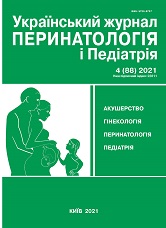Pybertygenesis progress' peculiarities of adolescent girls with gynecological pathology, born low or high to gestational weight
DOI:
https://doi.org/10.15574/PP.2021.88.26Keywords:
puberty, reproductive potential, low birth weight, macrosomia, menarcheAbstract
The perinatal background plays one of the most important roles in the development of future mothers. The study of factors influencing the formation of puberty is an urgent issue for improving the demographic situation in the country.
Purpose — to analyze the nature of the pubertogenesis's progress of adolescent girls depending on body weight at birth.
Materials and methods. A retrospective analysis was made of the course of pregnancy and childbirth of mothers of girls born with low or overweight. Menstrual function and somatic status among the study groups were prospectively assessed to identify markers of start and puberty disorders.
Results. The data obtained showed the reliability of the influence of body weight at birth on the development of menstrual function. Hypomenstrual syndrome was formed under the influence of fetal growth retardation syndrome, and vice versa, hypermenstrual syndrome was based on macrosomia in the antenatal period.
Conclusions. The identified features provide an opportunity for further research for the timely optimization of the formation of risk groups in the fertile age. Step-by-step monitoring and predictive models for the formation and maintenance of the ovarian reserve of this cohort implement differentiated pregravid preparation at an early reproductive age.
The research was carried out in accordance with the principles of the Helsinki declaration. The study protocol was approved by the Local ethics committee of the participating institution. The informed consent of the patient was obtained for conducting the studies.
No conflict of interest was declared by the author.
References
Bogdanova EA. (2011). Prakticheskaia hinekolohiia molodykh. Practical gynecology of young people. Moscow: Meditsinskaia kniha: 238.
Garces A, Perez W, Harrison MS, Hwang KS, Nolen TL, Goldenberg RL et al. (2020). Association of parity with birthweight and neonatal death in five sites: The Global Network's Maternal Newborn Health Registry study. Reprod Health. 17 (3): 182. https://doi.org/10.1186/s12978-020-01025-3; PMid:33334362 PMCid:PMC7745358
Huraseva AB. (2010). Reproduktivnoie zdorovie zhenshchin, rodivshikhsia s poliarnymi znacheniiami massy tela. Reproductive health of women born with polar body weights. Extended abstract of Doctor's thesis. Volgograd: 40.
IOZDP. (2012). Sayt Derzhavnoi ustanovy «Instytut okhorony zdorovia ditei ta pidlitkiv Natsionalnoi akademii medychnykh nauk Ukrainy». Ranneie i pozdneie poiavleniie pervoi menstruatsii (menarhe) u devochek. Early and late appearance of the first menstruation (menarche) in girls. URL: http://iozdp.org.ua/index.php/2012-09-03-08-35-35.
Ma R, Luo Y, Wang J, Zhou Y, Sun H, Ren X et al. (2020). Ten$year time trends in preterm birth during a sociodemographic transition period: a retrospective cohort study in Shenzhen, China. BMJ Open. 10 (10): e037266. https://doi.org/10.1136/bmjopen-2020-037266; PMid:33082182 PMCid:PMC7577040
Nazarenko LG, Nestertsova NS. (2016). Aspects of reproductive health in women with small and large for gestational age birth weight. Woman's Health. 10 (116): 53-55. URL: http://nbuv.gov.ua/UJRN/Zdzh_2016_10_12. https://doi.org/10.15574/HW.2016.116.53
Tuchkina I, Vygovskaya L, Novikova A. (2019). Features of uterine blood flow in adolescents with abnormal uterine bleeding of puberty. J Clin Med Kaz. 4 (54): 21-24. https://doi.org/10.23950/1812-2892-JCMK-00679
Tuchkina IA, Dobrovolskaya LA, Tuchkina MYu. (2016). Clinical and diagnostic aspects of primary dysmenorrhea in adolescence. Medicine (Almaty). 6 (168): 51-56.
Tuchkina IA, Tuchkina MYu, Novikova AA. (2019). Treatment of adolescent girls with abnormal uterine bleeding taking into account psychoemotional and vegetative status. Journal of Education, Health and Sport. 9 (5): 575-582. doi: 10.5281/zenodo.3239459.
Downloads
Published
Issue
Section
License
Copyright (c) 2022 Ukrainian journal of Perinatology and Pediatrics

This work is licensed under a Creative Commons Attribution-NonCommercial 4.0 International License.
The policy of the Journal “Ukrainian Journal of Perinatology and Pediatrics” is compatible with the vast majority of funders' of open access and self-archiving policies. The journal provides immediate open access route being convinced that everyone – not only scientists - can benefit from research results, and publishes articles exclusively under open access distribution, with a Creative Commons Attribution-Noncommercial 4.0 international license(СС BY-NC).
Authors transfer the copyright to the Journal “MODERN PEDIATRICS. UKRAINE” when the manuscript is accepted for publication. Authors declare that this manuscript has not been published nor is under simultaneous consideration for publication elsewhere. After publication, the articles become freely available on-line to the public.
Readers have the right to use, distribute, and reproduce articles in any medium, provided the articles and the journal are properly cited.
The use of published materials for commercial purposes is strongly prohibited.

